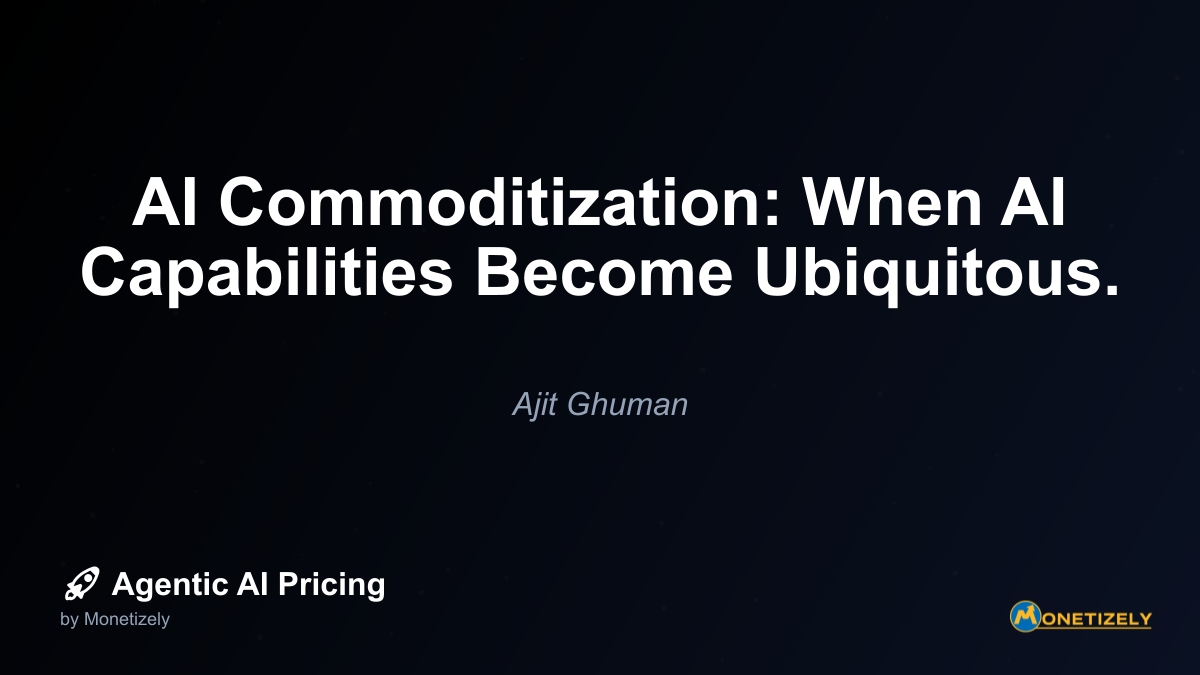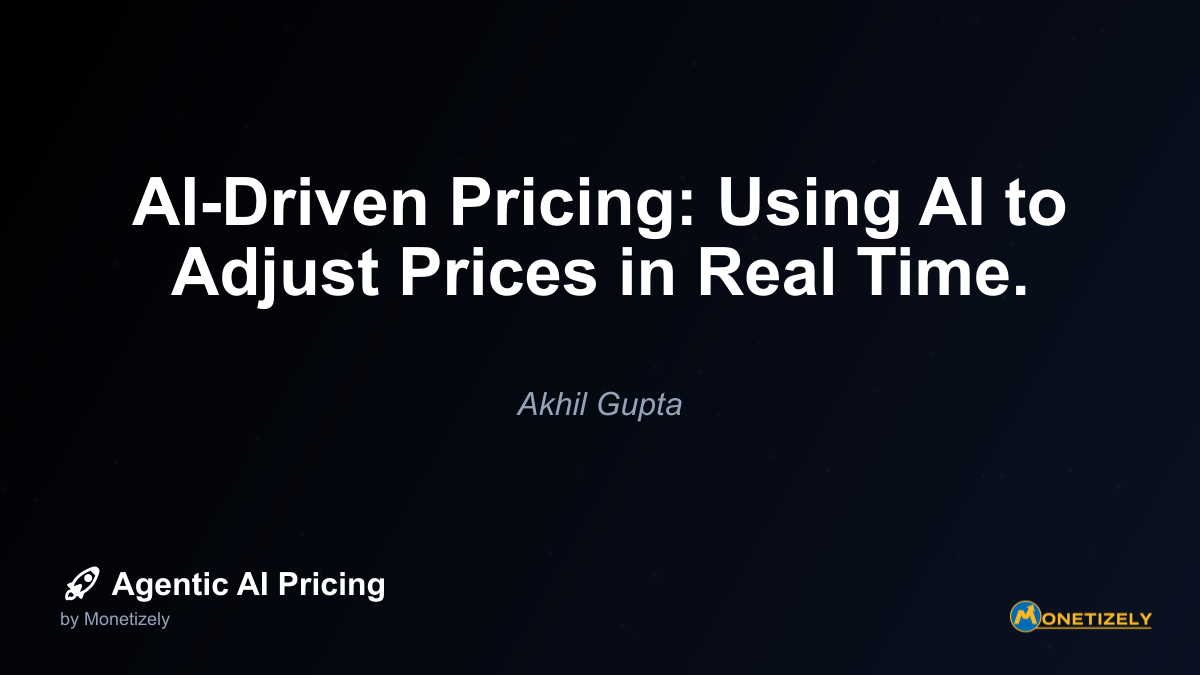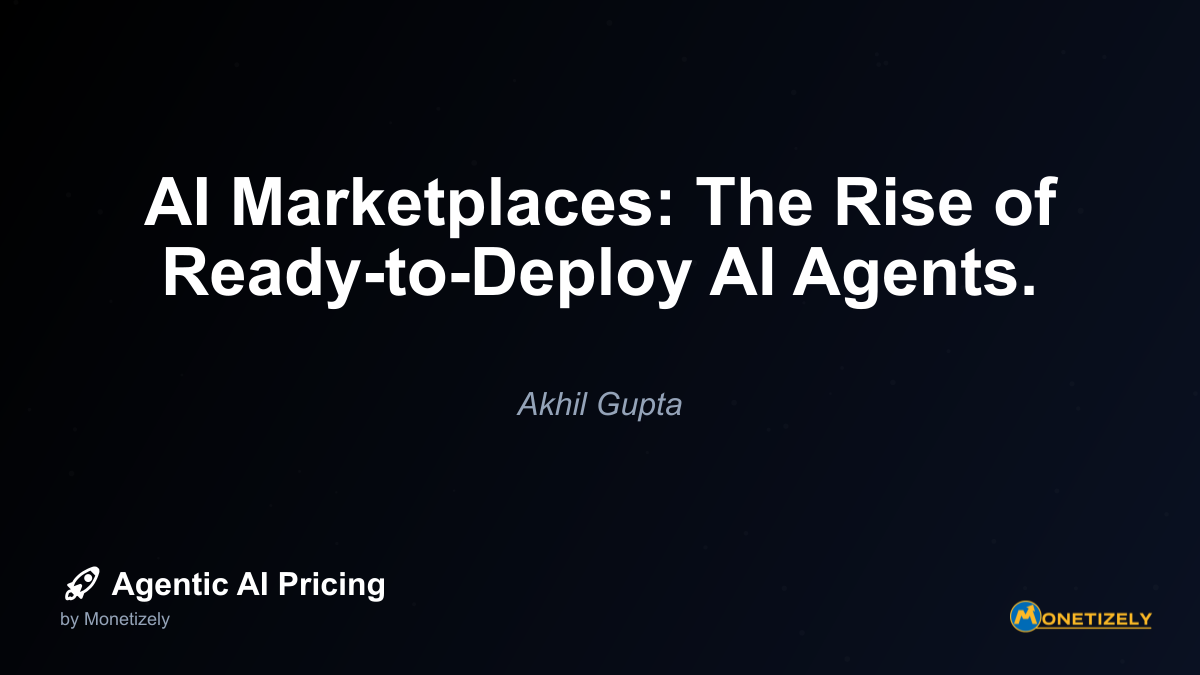· Ajit Ghuman · Emerging Trends · 7 min read
AI as a Colleague? Rethinking Pricing When AI Replaces Work.
AI and SaaS Pricing Masterclass
Learn the art of strategic pricing directly from industry experts. Our comprehensive course provides frameworks and methodologies for optimizing your pricing strategy in the evolving AI landscape. Earn a professional certification that can be imported directly to your LinkedIn profile.

The Talent Management Approach to AI
If AI systems function more like colleagues than tools, their implementation requires a talent management mindset rather than just technical deployment. This shift affects multiple organizational dimensions:
1. Onboarding and Training
Just as new employees require orientation and training, AI systems need:
- Knowledge transfer - Providing access to company-specific data, procedures, and norms
- Contextual understanding - Teaching the AI about organizational culture and priorities
- Performance expectations - Establishing clear metrics for success
- Integration with teams - Creating workflows that blend human and AI contributions
“The onboarding process for sophisticated AI is increasingly resembling human employee onboarding,” explains workforce transformation specialist Maya Rodriguez. “Organizations that approach implementation this way see significantly better adoption rates and ROI.”
2. Performance Evaluation
Like human colleagues, AI systems require ongoing assessment and feedback:
- Regular performance reviews against established KPIs
- Identification of improvement areas and retraining opportunities
- Recognition of exceptional performance and value creation
- Decisions about role expansion or reassignment based on capabilities
3. Career Development
The notion of AI “career paths” may seem strange, but organizations are beginning to implement structured progression for their digital workforce:
- Starting with simpler tasks before advancing to more complex responsibilities
- Expanding access to sensitive data and systems as trust is established
- Increasing autonomy levels based on demonstrated reliability
- Creating specialized “roles” as AI demonstrates particular aptitudes
Economic Implications of the Colleague Model
The shift toward viewing AI as colleagues rather than tools has profound economic implications for how organizations calculate costs, value, and return on investment.
Total Cost of Ownership Reconsidered
Traditional TCO calculations for software typically include:
- License/subscription costs
- Implementation expenses
- Maintenance and support
- Infrastructure requirements
- Training for human users
A colleague-oriented TCO model would add:
- Ongoing performance optimization costs
- Knowledge engineering and domain adaptation
- Integration with human workflows
- Governance and oversight requirements
- “Career development” investments
The Full-Time Equivalent (FTE) Benchmark
Organizations increasingly benchmark AI costs against human Full-Time Equivalent (FTE) metrics. This approach considers:
- Productivity comparison - What percentage of a human role can the AI fulfill?
- Quality comparison - How does AI output quality compare to human work?
- Speed differential - How much faster can AI complete equivalent tasks?
- Availability advantage - What is the value of 24/7 availability versus human working hours?
- Scalability factor - How easily can the AI’s capacity be increased compared to hiring?
McKinsey research suggests that by 2025, over 60% of large enterprises will evaluate AI investments using some form of FTE-equivalent analysis rather than traditional software ROI frameworks.
Competitive Salary Benchmarking
Some organizations are taking the colleague paradigm to its logical conclusion by benchmarking AI costs against competitive salary data. This approach:
- Identifies human roles partially or fully replaceable by AI
- Determines market compensation rates for those roles
- Establishes a “reasonable” price ceiling for equivalent AI capabilities
- Factors in the unique advantages and limitations of AI versus humans
- Creates a compensation-equivalent budget for AI investments
This approach helps prevent both underspending (missing valuable automation opportunities) and overspending (paying more for AI than equivalent human talent would cost).
Organizational Structure Implications
The colleague paradigm extends beyond budgeting to affect organizational structure and reporting relationships.
New Leadership Roles
As AI becomes more colleague-like, new leadership roles are emerging:
- Chief AI Officer (CAIO) - Executive responsible for AI strategy and governance
- AI Operations Manager - Oversees day-to-day management of AI systems
- AI Performance Analyst - Evaluates and optimizes AI contributions
- Human-AI Collaboration Lead - Facilitates effective teamwork between humans and AI
Hybrid Team Structures
Traditional organizational charts are evolving to incorporate AI “team members”:
- Augmented teams - Human teams with AI support for specific functions
- Supervised autonomy - AI systems with human oversight for critical decisions
- Collaborative pods - Balanced teams where humans and AI have complementary responsibilities
- AI-managed teams - Human contributors reporting to AI coordinators (emerging in limited contexts)
Pricing Implications for AI Vendors
For AI solution providers, the colleague paradigm creates both challenges and opportunities for pricing strategies.
Challenges to Traditional Models
Existing pricing approaches face several limitations:
- Per-seat models break down when AI functions independently of human users
- Consumption-based pricing poorly aligns with value when AI efficiency improves over time
- Enterprise licensing fails to capture departmental value differences
- Feature-based tiers don’t reflect the true value of autonomy and learning capabilities
Emerging Vendor Responses
Forward-thinking AI vendors are experimenting with new approaches:
1. Role-Based Pricing
Instead of generic tiers, pricing based on the specific organizational role the AI fulfills:
- AI Executive Assistant: $1,500-3,000/month
- AI Research Analyst: $2,000-4,000/month
- AI Customer Support Agent: $1,000-2,500/month
- AI Data Scientist: $3,000-6,000/month
Prices reflect the market value of equivalent human roles while accounting for AI’s unique advantages and limitations.
2. Outcome-Share Models
Rather than fixed fees, vendors take a percentage of measurable outcomes:
- 10-20% of documented cost savings
- 5-15% of revenue generated
- 8-12% of productivity improvements
- Custom arrangements for specialized applications
This aligns vendor success with customer value but requires sophisticated tracking and transparent reporting.
3. Capability Maturity Pricing
Pricing tied to the AI’s demonstrated capability level:
- Level 1 (Basic Automation): Fixed fee based on task volume
- Level 2 (Contextual Understanding): Base fee plus capability premium
- Level 3 (Autonomous Decision-Making): Value-based pricing with outcome guarantees
- Level 4 (Continuous Improvement): Partnership models with shared upside
This approach recognizes that AI value increases dramatically as capabilities mature.
Ethical and Philosophical Considerations
The colleague paradigm raises profound questions about the nature of work, value, and the relationship between humans and machines.
Value Attribution Challenges
When AI contributes significantly to business outcomes, questions arise about:
- How to attribute value between human and AI contributions
- Whether AI “deserves” compensation commensurate with its value creation
- If AI should be recognized as a stakeholder in organizational success
- How to balance investment between human and AI talent development
The Employment Relationship Reimagined
The colleague framing challenges traditional employment concepts:
- Does the organization “employ” the AI or merely license it?
- Who bears responsibility for AI actions and decisions?
- What rights and protections should apply to AI systems?
- How should organizations balance human and AI interests?
While current AI lacks consciousness or legal personhood, the colleague framing nonetheless pushes organizations to consider these questions in practical terms.
Practical Implementation: Getting Started
Organizations interested in exploring the colleague paradigm can begin with several practical steps:
1. Audit Current AI Capabilities
- Identify AI systems currently deployed across the organization
- Assess their autonomy level and decision-making authority
- Determine which functions most resemble colleague-like activities
- Evaluate the alignment between current pricing and actual value
2. Experiment with Role-Equivalent Budgeting
- Select a department with significant AI usage
- Create parallel budgets using traditional and colleague-oriented approaches
- Compare the insights and decision implications of each method
- Identify gaps in value capture from current budgeting approaches
3. Develop AI Performance Metrics
- Establish clear KPIs for AI systems similar to human performance reviews
- Create regular evaluation cadences for AI capabilities
- Implement feedback mechanisms to improve AI performance
- Benchmark AI contributions against human equivalents
4. Engage Vendors in Value Discussions
- Initiate conversations with AI providers about value-aligned pricing
- Explore pilot programs for outcome-based compensation
- Request transparency into provider cost structures
- Negotiate contracts that reflect the colleague paradigm
Looking Ahead: The Future of AI as Colleagues
The evolution from viewing AI as tools to seeing them as colleagues represents a fundamental shift in how organizations value, deploy, and manage artificial intelligence. As these systems become more capable, autonomous, and integrated into core business functions, traditional software paradigms will increasingly fall short.
Forward-thinking organizations have an opportunity to gain competitive advantage by:
- Adopting colleague-oriented budgeting approaches that better capture AI’s true value
- Implementing management practices that optimize AI performance and integration
- Negotiating vendor relationships that align costs with outcomes
- Creating organizational structures that facilitate human-AI collaboration
This paradigm shift doesn’t require attributing human-like qualities to AI systems—it simply recognizes that their functional role increasingly resembles colleagues more than tools, with all the budgetary, management, and structural implications that entails.
As one executive summarized: “We stopped thinking of our AI systems as expensive software and started thinking of them as uniquely talented team members. That simple mindset shift completely transformed how we budget for, deploy, and measure their contributions.”
The organizations that thrive in the age of agentic AI will be those that recognize this fundamental shift and adapt their pricing, budgeting, and management approaches accordingly.
Co-Founder & CEO
Ajit is the author of Price To Scale, a top book on SaaS Pricing and is the Founder of Monetizely. Ajit has led and worked in pricing and product marketing at firms like Twilio, Narvar and Medallia. His work has been featured in Forbes and VentureBeat. Ajit regularly consults with software companies from Seed stage to post-IPO on pricing strategy. Ajit is also a highly-rated co-instructor for 'The Art of SaaS Pricing and Monetization' on Maven.
Pricing Strategy Audit
Let our experts analyze your current pricing strategy and identify opportunities for improvement. Our data-driven assessment will help you unlock untapped revenue potential and optimize your AI pricing approach.




